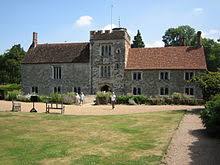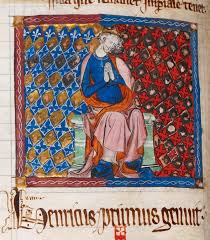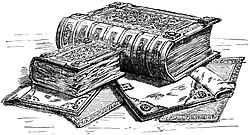Anglo-Saxon women played an important role in the years following The Conquest by providing the opportunity for intermarriage into the landowning class of Saxon society. This intermarriage gave legitimacy that cloaks the conquerors with respectability. Oderic Vitalis writing in the early 1130s speaks of rich English magnates who were Normans already settled in England before 1066 and also those who were Normans from mixed parentage and raised in England. Normans and French men who settled in England before 1066 were regarded as Anglici suggesting that to an extent integration had begun before Conquest.
 |
| convent or marriage? |
In the immediate post-conquest period there is evidence that William gave confirmation of lands and rights to the Anglici. However, according to The Anglo-Saxon Chronicles, William did not grant such favours for nothing. In fact the loyal English and Anglici bought their lands off the king. Queen Edith, Harold's sister and Edward the Confessor's wife, was confirmed in her lands after 1066. Similar provision may have been made for Harold's mother, Gytha, at least until she refused to pay the king's tax in Exeter and as a result brought William's wrath down on her dower town with a siege that lasted for three mid-winter weeks. On the other hand, manors belonging to the male members of the Godwin family e.g. the brothers and family of Harold II were divided amongst royal followers such as William Fitz Osbern (the central shires) and Odo of Bayeux (Kent and the south-east).
 |
| Eventually wealthy Anglo-Normans might build up such a manor, maybe after a few centuries |
An obvious way to secure land was to marry an heiress. The Breton Geoffery de la Guerche apparently acquired the lands of Leofine, Harold's brother who died at Hastings through marriage with Leofwine's daughter Aelfgifu. Sometimes the enforced marriage policy was not welcome and the ladies took refuge in nunneries 'not for love of religious life but from fear of the French', according to Oderic Vitalis. William also had been concerned to restore land to the English nobility who accepted Norman rule. Just after Hastings penances due from William's men for destruction were lessened if they married into the enemy. And this penance for Norman knights could be costly.
 |
| The Romantic Anglo-Norman marriage! She wed the knight! ( it is a very romantic pre-Raphaelite image rather than a faithful one) |
The bulk of male English survivors were royal servants and officials of varying kinds. For example Edward of Salisbury, the sheriff of Wiltshire, an official appointed by Edward the Confessor, survived Conquest and held onto his office. According to The Domesday Book he had an estate of 300 hides in 1086. Widows holding lands in alms were also able to acquire or recover something of the pre-conquest wealth and status. Thus, although the royal court was dominated by foreigners much of local business was in the hands of Englishmen.
 |
| A Sheriff such as Edward of Salisbury |
The integration of both peoples after The Conquest did draw on similarities of both peoples and was possible because of similarities as much as the imposition of one set of customs on another such as castle and cathedral building. Oderic Vitalis describes markets of villages and towns as 'filled with displays of French wares and merchandise'. William of Poitiers speaks of how the women of the English race excelled in embroidery and cloth of gold.
 |
| The most famous embroidery of the 11thC |
Marriage between incoming Normans and native English families was commoner than surviving sources indicate. There was inter-marriage at all levels of society. One evidence is that women's names changed less rapidly than men's names suggesting that newcomers sought English women as wives. Marriage with an English heiress might help secure possession of her family's lands. William was concerned immediately after the take-over to keep loyal Saxon/English magnates loyal. Though it must be said that the greatest Norman lords still sought their wives from France. It was those who made their fortune in England who found English wives an advantage. Here is an example of a 'lesser' heiress's marriage and how within this family the tradition continued through several generations.
Robert d'Oilly and Ealdgyth, daughter of Wigot of Wallingford
Matilda their daughter married Miles Crispin
Robert d'Oilley II married Edith, daughter of Farne, son of Sigulf and she, interestingly, had a son by Henry I called Robert. It is likely that Henry I, William the Conqueror's youngest son, married off his Saxon mistress to Robert d'Oilley.
Henry 1, of course, married the greatest English heiress of them all Maud /Matilda of Scotland who was the niece of Edgar Aetheling often regarded as the true and rightful heir to the English throne after Edward the Confessor's death.
 |
| Henry 1 who married the most prestigious heiress of all, Matilda |
Then, as well, there is the scandal concerning Gunnhild the youngest daughter of King Harold and Edith Swan-neck who eloped with Breton Alan of Richmond, (a cousin of King William) from Wilton Abbey. She is the subject of my new book in progress, The Swan-Daughter.
 |
| King William recorded land in the Domesday Book 1086 |
As a consequence inter marriage produced families that spoke English and Norman French. By the end of the 12th century an aristocracy that described itself as English indicates how English became the language of most Anglo-Normans. Sadly though, English wives and mistresses did face a twofold imbalance in power because with the Conquest Norman society gave them less influence than they previously held before 1066. Also, often, the dispossession of male English aristocrats meant that many aristocratic English women who married into the first generation of Normans, French and Bretons, lost what family backing they once had. Equally, they were a factor in the assimilation of two peoples and, by the end of the 12th century, marriage with the Anglo-Saxon heiress contributed to the triumph of an English identity
.jpg) |
| The Handfasted Wife is the story of Edith Swan-Neck and can be purchased from Amazon as kindle e book, for all e readers, paperback and also from Accent Press |




.jpg)
Interesting post, Carol. I used the idea of a Saxon heiress marrying a Norman knight in my romantic novel "Conqueror's Lady. I very much enjoyed doing the research about this period, but, sadly, that book didn't sell as well as my Regencies and my editor didn't want me to write any more Saxon stories.
ReplyDeleteIt may now be a better time for this period. I believe that it becoming popular. It is a lovely period to write about. I think the Victorians found it very romantic. Of course it was harsh too. The art and literature of the late 11 th and early 12 th century on the cusp of Romanz, with Anglo- Norman literature is interesting too. The illuminated lettering is beautiful too reflecting a mix of older English and continental style. A blog for another time perhaps. Thank you for reading and commenting.
ReplyDeleteHi Carol,
ReplyDeleteI'm a historian first and novel reader (and writer) second, but I found this post fascinating. You've very well encapsulated a wonderfully rich period of English history; I was fascinated to realise just how much inter-marriage and mixing there was between the conquering Normans and the conquered Saxons. Well done.
It is a fabulous period. I wrote The Handfasted Wife on a Phd creative writing programme at Royal Holloway and had the benefit too of The Bodlean Library Oxford. The more I delved the more I wanted to know. Like Scott in a way I am fascinated by periods of transition in history. Even though Ivanhoe for instance is so romantic and he wrote it several centuries ago he really captured the heiress point rather well in a work of fiction. We are fortunate now to have more understanding of historical sources and the nature of their thrust. Also I found writers such as Ann Williams very useful too.
ReplyDeleteI love this Carol!So much was going on in this period and you have captured it terrifically here.
ReplyDeleteI have been away from my computer for 2 weeks at my son's bedside and am catching up.
Thank you and actually I wrote a long academic essay on this but have only touched the surface here. It really was the essay I wrote to be accepted for the phd at Royal Holloway. It also underpins the thrust of the novels. Enjoy getting back on line, a feast!
ReplyDeleteThank you for that very interesting isight, Carol. I am researching the twelfth century arrival of the Norman-English in Ireland. My aim is to write about Aiofe who married Strongbow as his reward for assisting her father to regain his "kingdom" of Leinster. Their daughter, Isabel, married at Henry II's instigation to William Marshall is also a fascinating subject for study - her life will make a fine sequel to Aiofe's story. My problem is the paucity of information about women's lives and achievements in the period. I shall read your book with keen interest.
ReplyDeleteThank you, Frank for commenting. I think look at books on medieval women. Google Ann Williams as she may have articles. Specifically on Strongbow I am not sure but if I am in the Bodliean Library shall look for titles and post here. And I do hope you enjoy The Handfasted Wife.
DeleteHi Carole - I'm currently reading The Handfasted Wife on Kindle and am finding this period fascinating. I've studied various periods of history all my life but usually before and after this period. I'm really enjoying the book and especially its insights into the daily life of a noble Saxon woman - they seemed to do an awful lot of needlework as well as running a household - never idle for a moment! Can't wait for the next two books.
ReplyDeleteThank you, Margaret, for reading The Handfasted Wife. I am delighted that you are enjoying it. It took a long time to research and write but I promise the next book, The Swan-Daughter soon. I am currently editing this new story.
ReplyDeleteHi Carol, I have just finished The Handfasted Wife and loved it. You really brought the era to life. Am so looking forward to the next book in the trilogy. Bambi
ReplyDeleteHi Carol, I have just finished The Handfasted Wife and loved it. You really brought the era to life. Am so looking forward to the next book in the trilogy. Bambi
ReplyDeleteHi Carol, I've just finished reading the Handfasted Wife and loved it. You really brought the era to life. Am so looking forward to the next novel in the trilogy. Bambi
ReplyDeleteIt's an amazing post in favor of all the online visitors; they will get benefit
ReplyDeletefrom it I am sure.
Review my web blog